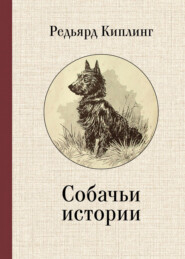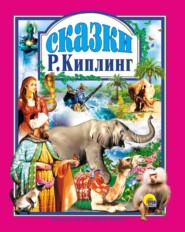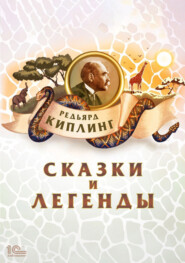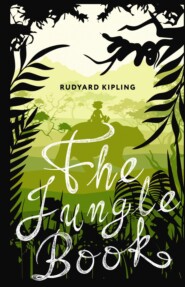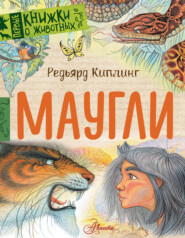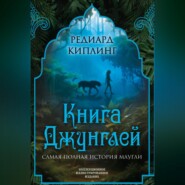По всем вопросам обращайтесь на: info@litportal.ru
(©) 2003-2024.
✖
The Jungle Book
Автор
Год написания книги
2019
Настройки чтения
Размер шрифта
Высота строк
Поля
Life & Times (#ulink_4741c3ec-b0c7-59dd-b828-864cec8d8f66)
About the Author
Rudyard Kipling was born in Mumbai, formerly known as Bombai, when it was part of British India during the days of the British Empire. He was born in 1865, the year that Lewis Carroll’s Alice’s Adventures in Wonderland was published, undoubtedly a genre of writing that later influenced his work. At the age of six, Kipling was sent to England to continue his education. He was deeply unhappy during this part of his childhood and it seems that this was when he began inventing companions in the form of anthropomorphic animals.
Having finished his schooling, Kipling returned to British India to become assistant editor of a newspaper in Lahore, which is now in Pakistan. He immediately felt at home and quickly forgot about his time in England. In 1887 Kipling moved from Lahore to Allahabad to work on another newspaper. He had already published a great many short stories by this time and two years later left India on a world tour. This included a trip across the United States and then a voyage by boat to England. Having ensconced himself in London he published his first novel The Light that Failed (1890), but evidently had a crisis of self confidence and suffered a nervous breakdown. His personal life was set to change in 1892 however, when he married Carrie Balestier, the sister of Wolcot Ballestier, with whom he had collaborated on another book.
Their honeymoon took them to Vermont in the United States, where they decided to settle because Carrie had fallen pregnant. The Kiplings remained in Vermont for four years. During this period Rudyard appeared to be content and wrote his best known work, The Jungle Book. Unfortunately a political crisis between Britain and the United States led to anti-British sentiment and Kipling felt it most from the press. A family feud between the Kiplings and Carrie’s brother proved the final straw and sealed Rudyard’s decision to leave America.
The Kipling family moved to the south coast of Devon, England and then East Sussex from 1902. By now Kipling was a famous man and enjoyed his growing celebrity in the first decade of the 20th century. In 1907 he won the Nobel Prize for Literature, such was his fame and reputation worldwide. World War I was, however, to have a tragic outcome for the Kiplings. In 1915 their son John was killed. He had gone to war in the blind spirit of enthusiasm that characterized the age and fallen at the Battle of Loos. Kipling felt eternal guilt at his son’s death because he had used his influence to get John accepted into the army following his initial rejection for having poor eyesight.
Following Kipling’s own death in 1936 his work became rather unfashionable, partly because of changing tastes and partly because the British Empire began to disintegrate following World War II. British India itself gained its independence from colonial rule in 1947 and was partitioned into Pakistan and India. In the latter half of the 20th century Kipling’s work became part of the cannon of English literary history, especially his two ‘Jungle Book’ collections, and he is now considered one of the all time greats.
In India, his legacy is a matter of contention because his writing is centred on colonial times and many of his characters are intrinsically racist. It isn’t that Kipling himself was prejudiced particularly, but that the culture among the British colonists was superior in its view of the natives. Kipling therefore wrote his characters as he witnessed real people around him. It would be true to say that many Europeans had an elitist attitude to non-Caucasian races at that time, so it would be inappropriate to judge Kipling by modern standards of political correctness.
The Jungle Book
When The Jungle Book is mentioned, most people think of the Disney animated film. This actually has very little to do with the stories of Rudyard Kipling, as Walt Disney only took the basic idea of anthropomorphic jungle animals and transformed them into lovable children’s characters. Kipling’s characters and stories are far darker and fantastical. In fact, Kipling deliberately wrote his stories as fables, to provide moral and ethical guidance to his readers, both young and old. The first collection of stories was published in 1894, quickly followed by a second in 1895, appropriately titled The Second Jungle Book.
Mowgli, the central human character, is a young boy who has been raised by a she wolf. He is thus in the unique position of being able to communicate with the various animals of the jungle. There had been various tales of children having been raised by wild animals and this is where Kipling drew his inspiration from. Some of those tales had an element of truth to them, but the majority were myths. Nevertheless, they made a solid foundation for Kipling’s stories, as Mowgli was the ideal transitional character. In essence he was half human, half animal in his psychology. He also possessed the naivety of a child and was therefore open-minded and fearless.
Mowgli appears in three of the stories in The Jungle Book. There are seven all told, with a song chapter following each one. As well as Mowgli and his animal companions, there are stories about a white seal named Kotick, a mongoose named Rikki-Tikki-Tavi, another boy named Toomai, and a group of domesticated Indian animals living in an army barracks. Kipling anthropomorphizes throughout The Jungle Book, so that he is able to tell his stories from the animals’ point of view. In doing so, he manages to comment on human behaviour in an objective, as opposed to subjective way. The animals in his books observe society, free from the constraints of culture and etiquette, but they also have their own interests and concerns. In English literature the practice of writing humanlike animals was established with Lewis Carroll’s Alice’s Adventures in Wonderland in 1865. The earliest use of this device however, dates back to the ancient Greeks, with Aesop’s fables. By using animals to teach people lessons in wisdom it somehow made it more acceptable and easier to digest, especially for younger readers.
In The Second Jungle Book we find Mowgli returned in the first five stories out of a total of eight. The second story, The King’s Ankus, illustrates very well Kipling’s use of Mowgli’s naive outlook on life. In the story Mowgli finds a very valuable, jewel encrusted ankus (an elephant stick), but to him it is just a curious object, which he tosses away unaware that to other humans it is priceless and even worth killing for. Kipling uses this as a metaphor for pointing out the ridiculousness of the want of wealth in society, when all that matters is that we are healthy and happy.
The remaining three stories are about an Indian politician, three scavenging animals having a quarrel and a young Inuit hunter. This final story and the story of the white seal Kotick, in the first book, are anomalies as they are not set in the jungle at all, but in the northern latitudes at or near the Arctic Circle. Although Kipling had spent some years living in India, he actually wrote both books whilst residing in the American state of Vermont, which borders with Canada. This is evidently where he got his inspiration for these two misplaced stories.
It also explains the distanced and romanticized view of India in his books. There is something about his approach to the stories that tells the reader that Kipling is evoking memories or confabulations of an India that perhaps never quite existed. This, however, does nothing to erode the charm of his writing and only serves to condense his images so that the reader is taken in fully by his fictional world.
PREFACE (#ulink_e6b81510-e75b-5481-bd2e-5a0c617a3c21)
The demands made by a work of this nature upon the generosity of specialists are very numerous, and the Editor would be wanting in all title to the generous treatment he has received were he not willing to make the fullest possible acknowledgement of his indebtedness.
His thanks are due in the first place to the scholarly and accomplished Bahadur Shah, baggage elephant 174 on the Indian Register, who, with his amiable sister Pudmini, most courteously supplied the history of ‘Toomai of the Elephants’ and much of the information contained in ‘Her Majesty’s Servants’. The adventures of Mowgli were collected at various times and in various places from a multitude of informants, most of whom desire to preserve the strictest anonymity. Yet, at this distance, the Editor feels at liberty to thank a Hindu gentleman of the old rock, an esteemed resident of the upper slopes of Jakko, for his convincing if somewhat caustic estimate of the national characteristics of his caste – the Presbytes. Sahi, a savant of infinite research and industry, a member of the recently disbanded Seeonee Pack, and an artist well known at most of the local fairs of Southern India, where his muzzled dance with his master attracts the youth, beauty, and culture of many villages, have contributed most valuable data on people, manners, and customs. These have been freely drawn upon, in the stories of ‘Tiger! Tiger!’, ‘Kaa’s Hunting’, and ‘Mowgli’s Brothers’. For the outlines of ‘Rikki-tikki-tavi’ the editor stands indebted to one of the leading herpetologists of Upper India, a fearless and independent investigator who, resolving ‘not to live but know’, lately sacrificed his life through over-application to the study of our Eastern Thanatophidia. A happy accident of travel enabled the Editor, when a passenger on the Empress of India, to be of some slight assistance to a fellow-passenger. How richly his poor services were repaid, readers of ‘The White Seal’ may judge for themselves.
MOWGLI’S BROTHERS (#ulink_764eec00-261e-5872-bcf5-de516eabb016)
Now Chil the Kite brings home the night
That Mang the Bat sets free –
The herds are shut in byre and hut,
For loosed till dawn are we.
This is the hour of pride and power,
Talon and tush and claw.
Oh, hear the call! – Good hunting all
That keep the Jungle Law!
Night-Song in the Jungle
It was seven o’clock of a very warm evening in the Seeonee hills when Father Wolf woke up from his day’s rest, scratched himself, yawned, and spread out his paws one after the other to get rid of the sleepy feeling in their tips. Mother Wolf lay with her big grey nose dropped across her four tumbling, squealing cubs, and the moon shone into the mouth of the cave where they all lived. ‘Augrh!’ said Father Wolf, ‘it is time to hunt again’; and he was going to spring downhill when a little shadow with a bushy tail crossed the threshold and whined:
‘Good luck go with you, O Chief of the Wolves; and good luck and strong white teeth go with the noble children, that they may never forget the hungry in this world.’
It was the jackal – Tabaqui, the Dish-licker – and the wolves of India despise Tabaqui because he runs about making mischief, and telling tales, and eating rags and pieces of leather from the village rubbish-heaps. But they are afraid of him too, because Tabaqui, more than anyone else in the jungle, is apt to go mad, and then he forgets that he was ever afraid of anyone, and runs through the forest biting everything in his way. Even the tiger runs and hides when little Tabaqui goes mad, for madness is the most disgraceful thing that can overtake a wild creature. We call it hydrophobia, but they call it dewanee – the madness – and run.
‘Enter, then, and look,’ said Father Wolf stiffly; ‘but there is no food here.’
‘For a wolf, no,’ said Tabaqui; ‘but for so mean a person as myself a dry bone is a good feast. Who are we, the Gidur-log [the Jackal-People], to pick and choose?’ He scuttled to the back of the cave, where he found the bone of a buck with some meat on it, and sat cracking the end merrily.
‘All thanks for this good meal,’ he said, licking his lips. ‘How beautiful are the noble children! How large are their eyes! And so young too! Indeed, indeed, I might have remembered that the children of Kings are men from the beginning.’
Now, Tabaqui knew as well as anyone else that there is nothing so unlucky as to compliment children to their faces; and it pleased him to see Mother and Father Wolf look uncomfortable.
Tabaqui sat still, rejoicing in the mischief that he had made: then he said spitefully:
‘Shere Khan, the Big One, has shifted his hunting-grounds. He will hunt among these hills for the next moon, so he has told me.’
Shere Khan was the tiger who lived near the Waingunga River, twenty miles away.
‘He has no right!’ Father Wolf began angrily – ‘By the Law of the Jungle he has no right to change his quarters without due warning. He will frighten every head of game within ten miles, and I – I have to kill for two, these days.’
‘His mother did not call him Lungri [the Lame One] for nothing,’ said Mother Wolf quietly. ‘He has been lame in one foot from his birth. That is why he has only killed cattle. Now the villagers of the Waingunga are angry with him, and he has come here to make our villagers angry. They will scour the Jungle for him when he is far away, and we and our children must run when the grass is set alight. Indeed, we are very grateful to Shere Khan!’
‘Shall I tell him of your gratitude?’ said Tabaqui.
‘Out!’ snapped Father Wolf. ‘Out and hunt with thy master. Thou hast done harm enough for one night.’
‘I go,’ said Tabaqui quietly. ‘Ye can hear Shere Khan below in the thickets. I might have saved myself the message.’
Father Wolf listened, and below in the valley that ran down to a little river, he heard the dry, angry, snarly, singsong whine of a tiger who has caught nothing and does not care if all the Jungle knows it.
‘The fool!’ said Father Wolf. ‘To begin a night’s work with that noise! Does he think that our buck are like his fat Waingunga bullocks?’
‘H’sh! It is neither bullock nor buck he hunts tonight,’ said Mother Wolf. ‘It is Man.’ The whine had changed to a sort of humming purr that seemed to come from every quarter of the compass. It was the noise that bewilders woodcutters and gipsies sleeping in the open, and makes them run sometimes into the very mouth of the tiger.
‘Man!’ said Father Wolf, showing all his white teeth. ‘Faugh! Are there not enough beetles and frogs in the tanks that he must eat Man, and on our ground too?’
The Law of the Jungle, which never orders anything without a reason, forbids every beast to eat Man except when he is killing to show his children how to kill, and then he must hunt outside the hunting-grounds of his pack or tribe. The real reason for this is that man-killing means, sooner or later, the arrival of white men on elephants, with guns, and hundreds of brown men with gongs and rockets and torches. Then everybody in the Jungle suffers. The reason the beasts give among themselves is that Man is the weakest and most defenceless of all living things, and it is unsportsmanlike to touch him. They say too – and it is true – that man-eaters become mangy, and lose their teeth.
The purr grew louder, and ended in the full-throated ‘Aaarh!’ of the tiger’s charge.
Then there was a howl – an untigerish howl – from Shere Khan. ‘He has missed,’ said Mother Wolf. ‘What is it?’






